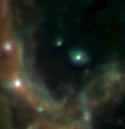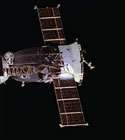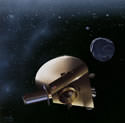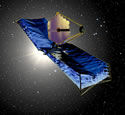
Image credit: NASA
A team of astronomers have taken the highest resolution mid-infrared picture ever taken of the center of our Milky Way galaxy. The image is so detailed, you can actually see dust swirling around the giant black hole located at the centre of the galaxy. The camera, called the Mid-Infrared Large-Well Imager, or Mirlin, is attached to the enormous Keck observatory in Hawaii.
The highest resolution mid-infrared picture ever taken of the center of our Milky Way galaxy reveals details about dust swirling into the black hole that dominates the region.
The image was taken by a team led by Dr. Mark Morris of the University of California, Los Angeles, at the Keck II telescope in Hawaii, with an infrared camera built at NASA’s Jet Propulsion Laboratory, Pasadena, Calif. The camera, called the Mid-Infrared Large-Well Imager, or Mirlin, used three different infrared wavelengths to build the color composite image available online at http://irastro.jpl.nasa.gov/GalCen/galcen.html.
The mid-infrared part of the electromagnetic spectrum comprises the wavelengths at which room temperature objects glow most brightly. Everything on Earth, including the telescope, the astronomers, and even the atmosphere, emits a bright glow in the mid-infrared. Seeing celestial objects though this glow is like trying to see stars during daylight; special techniques are needed to tease the stars from this glow to build a recognizable picture.
Near the center of the image, but not apparent at these wavelengths, is a black hole three million times heavier than our Sun. Its gravitational pull, so powerful that not even light can escape from its surface, affects the motion of dust, gas and even stars, throughout the region.
A veil of dust absorbs the visible light emitted by most of the stars near the Galactic Center. The light warms the dust, which then radiates in the infrared and becomes visible to the mid-infrared camera.
The image shows this dusty material spiraling toward the black hole, most notably the stream of gas and dust called the Northern Arm. When this material eventually falls into the black hole, it will release energy that affects everything in its vicinity. This event, which astronomers are certain has happened many times in the history of the Milky Way, may trigger the formation of a new generation of stars by causing other nearby dust clouds to collapse, or it may actually inhibit the formation of new stars if the released energy destroys those clouds. Either way, the black hole continues to grow larger as new material falls into it.
Astronomers know that the stars in this image are all very luminous, because less luminous stars appear very faint to a mid-infrared camera. A massive star nearing the last stages of its life, the red supergiant IRS7, is visible in this image as the smallish, bright spot just above the center. IRS7 is simply so luminous — more than 100,000 times as bright as our Sun — that we can see its starlight directly.
The “mini-cavity” in the center is a bubble that has apparently been evacuated of dust and gas. A star located at the center of the mini-cavity (not visible in this image) apparently blows this bubble with its powerful stellar wind. The “bullet” is a mysterious, fast-moving feature pointing roughly away from the mini-cavity, just below and to the right of the center. It may be a jet composed of gas and dust.
Other members of the Mirlin imaging team, along with Morris, are Dr. Andrea Ghez, Dr. Eric Becklin and Angelle Tanner of UCLA; Drs. Michael Ressler and Michael Werner of JPL; and Dr. Angela Cotera Hulet of the Arizona State University, Tempe, Ariz. The camera was built at JPL by Ressler and Werner. Operation of Mirlin is supported by a grant from NASA’s Office of Space Science, Washington, D.C. Some findings based on this image have been published in the Astrophysical Journal.
Studying processes in the center of our own galaxy may teach astronomers more about much more active, more distant galactic nuclei — objects like quasars and Seyfert galaxies, which are the most violent places known in the universe. More information about both the center of our Milky Way and the centers of other galaxies may be obtained with future instruments that have higher resolution and greater sensitivity.
For example, NASA is planning a similar infrared camera, the Mid-Infrared Instrument, one of three instruments that will fly aboard the James Webb Space Telescope, launching in 2010. This camera will achieve resolution roughly equivalent to the Keck images, but because it will orbit above the warm glow emitted by Earth’s atmosphere, it will be 1,000 times more sensitive. Using this instrument, astronomers will be able to study the centers of galaxies all the way to the edge of the observable universe.
JPL, in conjunction with a consortium of European countries and the European Space Agency, is developing the Mid-Infrared Instrument. The James Webb Space Telescope is managed by the Goddard Space Flight Center, Greenbelt, Md.
JPL is a division of the California Institute of Technology in Pasadena.
Original Source: NASA/JPL News Release



